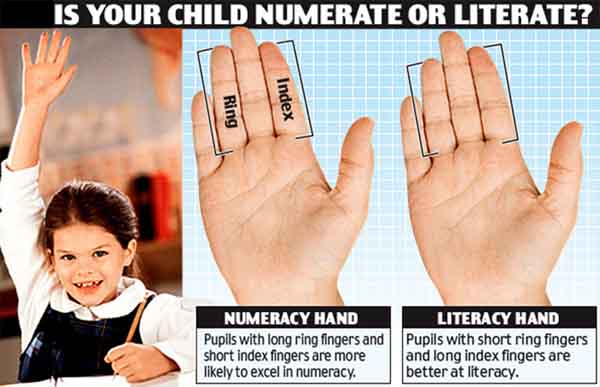|
Parents can predict their children's exam performance simply by looking at their hands, according to research.
Psychologists claim that results in English and maths tests are linked to the length of fingers.
Pupils with longer ring fingers are said to be more likely to excel in numeracy while those with shorter ring fingers tend to be more adept at literacy.

Scientists believe the trends can be explained by the levels of testosterone and oestrogen that children are exposed to in the womb. The sex hormones are thought to govern brain development as well as finger length.
Mark Brosnan, who led the study at the University of Bath, said: "Testosterone has been argued to promote development of the areas of the brain which are often associated with spatial and mathematical skills:
"Oestrogen is thought to do the same in the areas of the brain which are often associated with verbal ability.
Interestingly, these hormones are also thought to have a say in the relative lengths of our index and ring fingers.
We can use measurements of these fingers as a way of gauging the relative exposure to these two hormones in the womb.
And, as we have shown through this study, we can also use them to predict ability in the key areas of numeracy and literacy."
|
 
|
In the research project, which has been published in the British Journal of Psychology,
scientists measured the finger lengths of 75 seven-year-olds by using photocopies of their palms.
For each child, they took measurements of the index and ring fingers on their right hands.
They divided the length of the index finger by the length of the ring finger to calculate each child's 'digit ratio'.
Adult women usually have ratios of one - with index and ring fingers of equal length.
The average for men is lower, at 0.98, since they tend to have longer ring fingers than index fingers, suggesting greater exposure to testosterone in the womb.
|
Using scores in 'key stage' English and maths tests, the researchers compared the measurements of the study group - who all attended an infants' school in Bath - with their performance in the classroom.
They found that children with smaller digit ratios - a longer ring finger and greater pre-natal exposure to testosterone - were more likely to be better at maths than English.
Similarly, pupils with higher ratios - shorter ring fingers and greater exposure to oestrogen - performed better in English tests than maths.
Longer ring fingers in boys were also strongly linked with higher scores in numeracy tests.
 Find a Palm Reader in the UK! Find a Palm Reader in the UK!
Related sources:
The Finger Book
What our fingers can tell us
What they say about men with long ring fingers
Left Handedness & Finger Asymmetry
Giving Science the Finger
Digit Ratio & Agression
Finger Length & Facial Characteristics
Finger Length & Osteoarthritis
Pointing a Finger at Sports Success
Double Digits
Talk to the Hand
www.dailymail.co.uk
www.bath.ac.uk
www.ingentaconnect.com
www.sciencedaily.com
HAND READING NEWS
|

